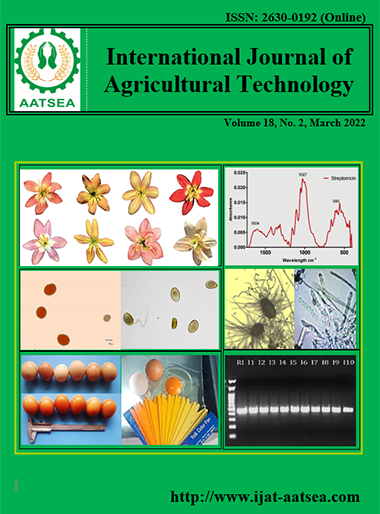Development and evaluation of the formula for healthy mushroom beverage with high β-glucan prepared from Schizophyllum commune Fr. in Thailand
Main Article Content
Abstract
Schizophyllum commune Fr., an edible macrofungus, and is a fungus with the unique taste and high β-glucan content. Therefore, the beverage with high β-glucan was evaluated the qualities of the beverage formula. Results was exhibited that the formula of S. commune beverage was prepared by the ratio of the dried powder of 1-day-old fruting bodies of S. commune with water at a ration of 1:15, and varied the amount of honey and lime juice. The criterion used for selecting the best formula was the amount of β-glucan content and antioxidant properties. The formulation contained with 10% honey and 1 % lime juice received the highest the sensory scores of most acceptable (7.03+1.00), with total phenolic compound of 1.23 + 0.11 mg/ml and amount of β-glucan content of 7.24 + 0.31 % v/v as well as high potential antioxidant activity of 82.43 + 0.61 DPPH % and 91.91 + 0.23 ABTS % (p < 0.05). Then, the formula development of beverage by using ratio profile test (RPT) which found to be closedly related to an ideal formula contained 10% honey and 1.5% lemon juice, which had 7.99 + 0.31% (v/v) β-glucan and potential antioxidant activity of 82.92 + 0.43 DPPH %, and 92.55 + 0.33 ABTS % which was higher than the control formula. The physical and chemical characteristic of the product was 2.25+ 0.03 lightness (L*), (-1.25)+ 0.07 redness (a*), 2.35+ 0.07 yellowness (b*), 14.40 + 0.10 °Brix total soluble solid, 3.61+ 0.01 pH, 89.86 + 0.06 % moisture content, 0.36 +0.01 % protein content, and 8.67 + 0.07 % carbohydrate content. Viable plate count, yeast and mold count exhibited less than 10 CFU/ml. The study resulted to be benefit to the local beverage industry in Thailand
Article Details

This work is licensed under a Creative Commons Attribution-NonCommercial-NoDerivatives 4.0 International License.
References
Abd. Razak, D. L., Jamaluddin, A., Abd. Rashid, Nur Y., MohdFadzil, N. H., Ajila Sani, N. and Abdul Manan, M. (2018). Comparative Evaluation of Schizophyllum commune Extracts as Potential Cosmeceutical Bio-Ingredient. International Journal of Applied Pharmaceutics, 5:37-41.
Antunes, F., Marçal, S., Taofiq, O., Morais, A. M. M. B., Freitas, A. C.,1, Ferreira, I. C. F. R. and Pintado, M. (2020). Valorization of Mushroom By-Products as a Source of Value- Added Compounds and Potential Applications. Molecules, 25:2672.
Arbaayah, H. H. and Kalsom, Y. (2013). Antiodiant properties in the oyster mushroom (Pleurotus spp.) and split gill mushroom(Schizophyllum commune) ethanolic extracts. Mycosphere, 4:661-673.
Basso, V., Schiavenin, C., Mendnca, S., Goncalves de Siqueira, F., Salvador, M. and Camassola., M. (2020). Chemical features and antioxidant profile by Schizophyllum commune produced on different agro-industrial wastes and byproducts of biodiesel production. Food Chemistry, 329:1-7.
Chandrawanshi, N. K., Tandia, D. K. and Jadhav, S. K. (2017). Nutraceutical properties evaluation of Schizophyllum commune. Indian Journal of Scientific Research, 13:57-62.
Goh, L. M., Barlow, P. J. and Yong, C. S. (2003). Examination of antioxidant activity of Ginkgo biloba leaf infusions. Food Chemistry, 82:275-282.
Gulcin, I., Oktay, M., Kirecci, E. and Kufrevioglu, O. I. (2003). Screening of antioxidant and antimicrobial activities of anise (Pimpinella anisum L.) seed extracts. Food Chemistry, 83:371-382.
Hajimahmoodi, M., Aliabadipon, M., Maghaddam, G., Sadeghi, N., Oveisi, M. R. and Jannet, B. (2012). Evaluation of in vitro antioxidant activities of lemon juice for safety assessment. American Journal of Food Technology, 7:708-714.
Jiang, J. and Sliva, D. (2010). Novel medicinal mushroom blend suppresses growth and invasiveness of human breast cancer cells. International Journal of Oncology, 1:1529-1536.
Klaus, A., Kozarski, M., Niksic, M., Jakovljevic, D., Todoronic, N. and Van Griensven, Leo J. L. D. (2011). Antioxidative activities and chemical characterization of polysaccharides extracted from the basidiomycete Schizophyllum commune. LWT-Food Science and Technology, 44:2005-2011.
Manzi, P. and Pizzoferrato, L. (2000). Beta-glucan in edible mushrooms. Food Chemistry, 68:315-318.
Mayakrishnan, V., Abdullah, N., Abidin, M. H. Z., Fadzil, N. H. M., Johari, N. M. K., Aminudin, N. and Abidin, N. Z. (2013). Investigation of the antioxidative potential of various solvent fractions from fruiting bodies of Schizophyllum commune (Fr.) mushroom and characterization of phytoconstituents. Journal of Agricultural Science, 5:1-11.
Megazyme International, Ireland Ltd., (2013). Mushroom and yeast beta-glucan assay procedure booklet, K-YBGL. 09/13. Wicklow, Ireland.
Menakongka, A., Ruaengsritanyakij, S., Sripayak, S., and Suthiphongchai, T. (2019). Anti-proliferation and Anti-migration of Schizophyllum commune extracts on Human Cholangiocarcinoma Cell Line.Vajira Medical Journal: Journal of Urban Medicine, 63:326-336.
Mongkontanawat, N. (2013). Product development of fruit tea mixed with “HedKrang” (Schizophyllum commune). International Journal of Agricultural Technology, 9:1665-1676.
Mongkontanawat, N. and Phuangborisut, S. (2019). Product development of mushroom beverage with high β-glucan content from local mushrooms. International Journal of Agricultural Technology, 15:959-974.
Muthuramalingam, K., Singh, V., Choi, C., In Choi, S., Park, S., Kim, · Y. M., Unno, T. and Cho, M. (2019). Effect of mushroom (Schizophyllum spp.) derived β-glucan on low-fiberdiet induced gut dysbiosis. Journal of Applied Biological Chemistry, 62:211-217.
Rattanadilok Na Phuket, S., Sangkaew, T., Chanapan, P. and Techaoei, S. (2019). Biological activity of β-glucan from edible mushroom, Schizophyllum commune in Thailand. International Journal of Applied Pharmaceutics, 11:110-112.
Senthilraja, P. and Kathiresan, K. (2015). In vitro cytotoxicity MTT assay in Vero, HepG2 and MCF-7 cell lines study of Marine Yeast. Journal of Applied Pharmaceutical Science, 5:080-084.
Steel, R. G. D., Torrie, J. H. and Dickey, D. (1997). Principles and procedures of statistics. New York, USA: McGraw-Hill.
Wasser, S. P. and Weis, A. L. (1999). Therapeutic effects of substance ocuring in higher Basidiomycetes mushroom: a modern perspective. Critical Review in Immunology, 19:65-96.
Watts, B. M., Yumaki, C. L., Jeffery, L. E. and Elais, L. G. (1989). Basic sensory methods for food evalution. The International Development Research Centre, Ottawa, Canada. P.159.
Yin, L., Duan, J. J., Bian, X. W. and Yu, S. (2020). Triple-negative breast cancer molecular subtyping and treatment progress. Breast Cabcer Research, 22:1-13.


